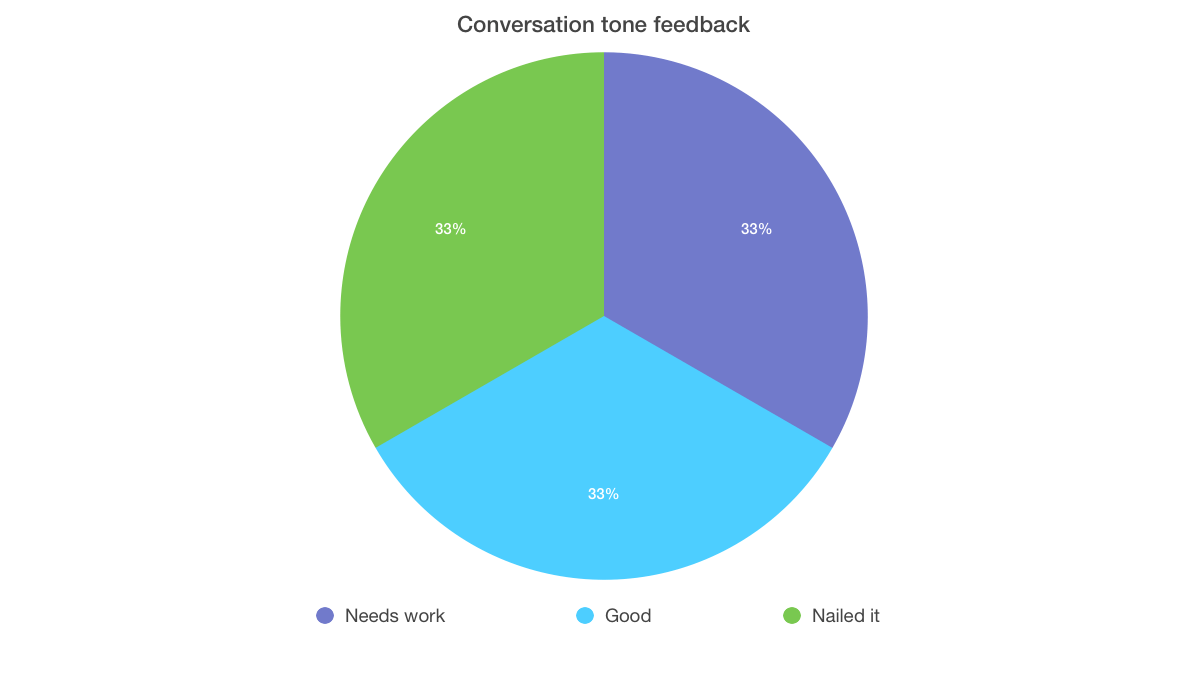
PREACH: A tone of voice framework for customer support
Main illustration: Jean Wei
Often in life, it’s not what you say but how you say it that makes all the difference. This is even more true in a customer support conversation, so getting your company’s tone of voice just right is incredibly important.
Once you’ve figured out how you speak to your customers, the next challenge is getting your team aligned so you can ensure a consistent customer experience.
At Intercom, we strive to maintain excellent customer relationships using conversational support. Conversational support is the modern way to resolve customer questions through a digital-first, messaging-based interaction. This means that customers and agents can be connected in real time or asynchronously, and customers can stop and restart the conversation when it’s convenient – without ever losing context.
It’s called conversational because it, well, feels more like an ongoing conversation: natural, easy, and convenient. So it follows that we want to make sure that every time we talk to a customer, we strike that perfect balance of friendly, efficient, and helpful.
How do we do that? With a simple six-step framework that helps us to create consistency, stay on brand, and still deliver personalized, conversational support at scale.
Measuring our customer experience
As a support team, we use a number of metrics to ensure that we’re always exceeding our (and our customers’) high standards. When it comes to measuring conversations, we’ve implemented a peer review system, where every member of our customer support team consistently reviews their teammates’ conversations. During a review, conversations are rated on two main aspects: quality and tone of voice.
“One of the biggest challenges for any growing customer-facing team is finding a method you can rely on to teach every new team member exactly how you talk to your customers”
In simple terms, quality covers the correctness and accuracy of the answers provided. While we hold a high bar for customer satisfaction, and encourage our team to go beyond simply providing correct answers, it’s a simple metric to break down and can be rated objectively with relative ease.
Tone of voice, on the other hand, presents certain challenges. As soon as you look at the approach your teammates have taken to provide those answers, objectivity is inevitably replaced by subjectivity.
We conducted a calibration where the entire team rated the same 30 conversations for quality and tone on a three point scale. The resulting pie chart may have strongly resembled the marque of a certain German luxury vehicle, but it certainly didn’t confirm that conversations were rated consistently across teammates.

This shouldn’t have come as a surprise. Our existing guide for speaking with customers was five years old, and 15 points long – it was written to be comprehensive rather than memorable. Furthermore, it captured what the Support team at the time already knew about how they spoke to customers. No one was referring to it, because they had already internalized its most essential principles.
But as a rapidly scaling company, our Support team needed to be able to scale with us. One of the biggest challenges for any growing customer-facing team is finding a method you can rely on to teach every new team member exactly how you talk to your customers – this consistency is key to ensuring high customer satisfaction.
Why tone is so important (and such a challenge) in customer support
Customer support guidelines often focus on the specific steps reps should take to help customers, but tone of voice may be the single most important factor in support performance. The tone you take with a customer will go a long way towards determining the quality of their support experience. No matter how helpful you are, if you communicate with impatience, condescension, or disinterest, then their experience will be negative.
“The proper framework will give your support reps a clear idea of the tone of voice they should take, and will communicate this in an intuitive, insightful, and unique manner”
However, this presents a challenge: besides simple truisms like “be friendly” or “be nice,” it’s hard to standardize tone across a support team. This is where a customer support tone of voice framework comes in: the proper framework will give your support reps a clear idea of the tone of voice they should take, and will communicate this in an intuitive, insightful, and unique manner.
Teaching tone of voice
We realized the biggest issue with our previous guidelines for tone of voice was their inaccessibility. Even if the guide’s content was perfect, it was a little too long to recall every point, meaning that it wasn’t something that could be easily referred to when speaking to customers or reviewing a teammate’s conversation.
In coming up with a way to make these guidelines more easily understood, remembered, and shared, we considered alliterative phrases, mnemonics and even rhymes. We eventually settled on an acronym: PREACH.
PREACH means that to maintain a customer-centric approach, we aim to be Proud, Responsible, Empathetic, Articulate, Concise and Human.
- Proud: In our mission to make internet business personal, we often make bold decisions about which features to build. We own this mission and its impact unapologetically.
- Responsible: If a bad feature or bug ships and a customer is disappointed or frustrated, it’s on us. We don’t blame the engineers, or attempt to come up with excuses. We take ownership of our mistakes, and move forward while trying to manage customer expectations.
- Empathetic: We acknowledge, and aim to truly understand how our customers feel and handle each conversation accordingly. We match their tone of voice, and the situation wherever we can.
- Articulate: Gracefully augmenting your conversations with personal language, emojis and GIFs is encouraged, but typos, bad punctuation or poor phrasing make us look less professional. This might seem like an obvious one, but it’s important to keep the fundamentals front and center in order to reinforce our high bar and maintain customer engagement during a conversation.
- Concise: No matter how much fun you can have with your customers, never forget they contacted you for a reason. Our job is to fully understand their needs and resolve them as quickly as possible. Also keep the medium in mind here – with a Messenger window, your answers will usually be read in a compact space.
- Human: With Resolution Bot and other automations handling your customers’ simpler questions, you’re left with all the conversations where a human approach is the best one. Take this opportunity to really connect with your customers, and if you wouldn’t say the words in a “normal” spoken interaction, don’t say them during a customer interaction.
Practice your customer support tone
Crafting the PREACH customer support tone of voice framework is all well and good, but how do we apply it? In our customer support training sessions (where we introduce new teammates to the Intercom customer support organization as a whole), we include a lesson on PREACH, to make sure it’s ingrained right from the start.
Within these sessions, each new employee dives into conversations with our customers and applies the framework in real-time. The PREACH framework serves as the life vest while they learn how to swim, providing excellent customer support while still allowing them the opportunity to learn on their own and get direct customer feedback on the process. We encourage people to embrace their own voice and approach within these guidelines when supporting customers.
“PREACH is a powerful enforcer of our culture and standards when supporting customers”
Lastly, PREACH not only acts as a guideline for our tone of voice, but also as a powerful enforcer of our culture and standards when delivering a high quality customer experience. We’re proud of the product we make and we keep our conversations personal, whether it be with customers or teammates. This can have a lasting impact on new team members as they get settled at Intercom. It shows what we value, and the standards that we hold.
At the end of the day, it boils down to practicing what we PREACH.








